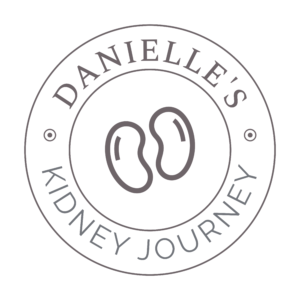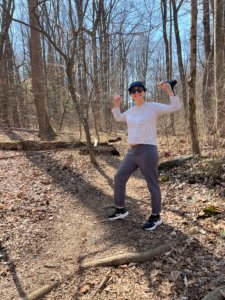Tracking Every Step: Life with Kidney Disease and Hope for Recovery
Good morning everyone,
One of the most interesting things about kidney disease is how much monitoring I do of my body. Prior to my injury—I call it my injury because I was diagnosed with Acute Kidney Injury initially—I would weigh myself occasionally, drink water because it felt good, and go through periods of emotional eating where I’d put on 12–15 pounds (high school and COVID, for example), but mostly kept a steady weight. Once I was hit with kidney disease, everything changed. I had to weigh myself every day to ensure I wasn’t retaining water, which would mean my kidneys weren’t filtering fluids properly. I had to monitor every single thing I ate—low salt, low potassium, and low phosphorus—so foods like bananas, avocados, tomatoes, and potatoes were suddenly off-limits.
The first time I came home from the hospital in March 2023, I was scared. I remember not knowing what I could eat at first. One time, I had a banana, and the next day, when I went to dialysis, I was writhing in pain. My potassium levels were too high, and when the dialysis machine cycled my blood, my shin and thigh muscles cramped so badly that I was tearing up. The nausea was overwhelming, and I dry-heaved from the intensity of it.
It left me afraid—afraid to eat, unsure of what to do. Luckily, I had Marcy, a Jamaican-born caregiver who stayed with us to support Barney and me. She made me porridge, salt-free veggie and chicken curries, and fruit bowls. Slowly, my spindly legs and anorexic-looking arms began to put on some weight. I started reading about kidney-friendly foods, experimenting with keto recipes I could modify, and even finding restaurants that could make certain dishes for me. I became a regular at a few places—including a Thai restaurant that whenever I walked in, the server would say, “Low-sauce Pad Thai, no sprouts, no tomatoes or mushrooms, extra veggies?” before I even ordered.
I also had to track my urine output. Every time I peed, I had to use a collection hat under the toilet seat, then transfer it to a gallon jug, which I stored in a cooler on the deck—because keeping it in the fridge felt too gross. I had to do this monthly to determine if my kidneys were filtering fluids. (I eventually found out that they were moving fluid but not actually filtering it.)
In the year I lived with low-functioning kidneys, my body was never the same as before. It used to be strong—lean muscle, ready for a long walk or hike. Even at seven months pregnant, Ian and I gallivanted around Italy, walking up to nine miles a day. But this last year, my body has been lean but soft, with little muscle mass. I could walk for 30–45 minutes a day, but that was all I had in me—exercise felt good, but it always came at a cost, usually a midday nap or overwhelming fatigue.
The exhaustion was constant, like a ripple of depletion running from my throat, like my life force was always draining. No matter how much I rested, I never woke up feeling refreshed. The fatigue had a relentless, nagging quality, similar to anxiety. And while I’d dealt with anxiety before and had strong coping mechanisms, I had no tools to manage this. Looking back, I can see now that my year on dialysis overlapped with depression in ways I didn’t fully recognize at the time.
Now, post-transplant, monitoring looks different. Every morning, I take my temperature, blood pressure, and weight. I track my urine output and fluid intake to ensure I’m not showing signs of infection and that my new kidney is functioning—since weight and blood pressure are key indicators of kidney health.
I also take my medications at exactly 7:30 AM and 7:30 PM because my anti-rejection drugs need to stay at precise levels in my bloodstream. If they drop too low, my body might see the new kidney as an invader.
Every time I pee, I measure it and write it down. Every time I drink, I calculate it. Unlike last year, I now need potassium and phosphorus in my diet, so I’ve been reintroducing foods like tomatoes, potatoes, and avocados. But I haven’t had a banana yet—I still have a bit of PTSD from last year’s incident.
I thought eating these foods again would feel divine. And while there is a sense of newness, it’s not quite the monumental experience I expected. After all, I still had little tastes of Ian’s food last year—I never fully forgot what they were like. But there are moments of rediscovery. For example, when I had bechamel lasagna, each bite of ground beef popped in my mouth, swirling around like a relaxing whirlpool. And last night’s potato latkes? The starchiness lingered in a way that was unexpectedly pleasant.
I look down at my body now, and it’s still different. My legs have lost their softness and become spindly again. My abdomen is swollen and lopsided on the right side. I try to walk every day to build strength and improve circulation to my new kidney, but something is different now.
Before, when I looked at my body on dialysis, I didn’t have much hope. Hiking, Pilates, strength training—things I once loved—felt like they belonged to someone else’s life, not mine. But now, as I begin to experience this third iteration of my body, I can see it differently. I imagine my calf muscles growing strong again, my arms gaining definition, my thighs carrying me up boulders and steps with ease. I picture myself visiting friends in Colorado and going on my favorite hikes again.
And that fills me with possibility.
My body isn’t there yet. But the possibility is back. And after everything, having hope again feels really, really good.
Signing off for now,
Danielle
Interested in becoming a living kidney donor? Learn more through DOVE, a nonprofit supporting veterans in need.



